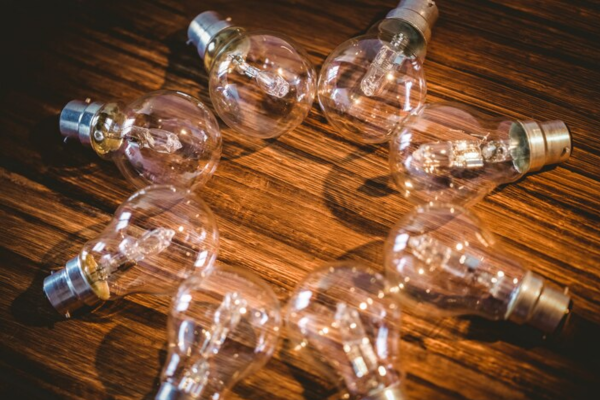The timeless glow of an incandescent light bulb has been lighting up our homes, offices, and imaginations for more than a century. Incandescent light bulbs are still a representation of simplicity and creativity, even though they are being phased out in favor of more energy-efficient lighting solutions. We shall examine the background, practicality, and timeless appeal of this iconic lighting solution in this blog.
How It Works:
- Incandescent light bulbs work by a simple method. An electric current heats a filament, usually composed of tungsten, inside a sealed glass bulb until it glows, creating light. The bulb lasts longer because there is less oxygen within, which keeps the filament from burning out too soon.
- Despite having a straightforward design, this procedure is intrinsically ineffective. Approximately 5–10% of the energy used is transformed into visible light; the rest is lost as heat. Alternative lighting technologies like light-emitting diodes (LEDs) and compact fluorescent lamps (CFLs) were developed as a result of this inefficiency.
The warm glow:

Warm glow bulbs refer to a specific type of LED light bulb that mimics the effect of traditional incandescent or halogen bulbs when dimmed. These bulbs provide a warm, cozy lighting effect, making them ideal for home environments, restaurants, and cozy spaces.
Even though incandescent bulbs are inefficient, they have a certain beauty. Many people find their warm, yellowish light to be aesthetically pleasing and reassuring. This warm light can arouse feelings of nostalgia and create a homely atmosphere.
The Enduring Appeal:
Because of their warm, natural light, incandescent bulbs have a particular place in many people’s hearts, despite their inefficiency. Their color reconstruction index (CRI), which gives colors a realistic depiction, is almost flawless. For applications like photography, art studios, and vintage-style interiors where mood and color fidelity are crucial, this feature makes them a favorite.
These bulbs are a popular option for cozy areas, restaurants, and residences since they produce a welcoming and warm atmosphere. Their gentle amber glow, in contrast to harsh blue-toned lights, gives a vintage appeal that many people associate with coziness and private parties.
Environmental and Economic Impact
Incandescent light bulbs’ inefficiency has serious negative effects on the environment and the economy. Compared to more contemporary options, they require more energy, which raises power costs and increases greenhouse gas emissions. Many countries have put laws into place to gradually replace conventional incandescent light bulbs with energy-efficient alternatives in recognition of these disadvantages.
However, because LED bulbs last longer and consume 80% less energy than incandescent bulbs, they are the most environmentally responsible choice. Additionally, because LEDs require less energy, power plants are under less pressure, which lowers greenhouse gas emissions and protects the environment.
Modern Alternatives
The market is currently dominated by CFLs and LEDs, which provide remarkable longevity and energy economy. However, energy-efficient incandescent-style lights like halogen and LED filament bulbs have also been made possible by developments in lighting technology. While using less energy, these alternatives replicate the look of conventional incandescent bulbs.
Modern alternatives to conventional incandescent bulbs offer greater longevity, energy efficiency, and intelligent features thanks to improvements in lighting technology. These substitutes offer adaptable lighting options for various need in addition to saving electricity.
Modern Applications
- Even though LEDs and CFLs currently rule the market, incandescent bulbs are still used in some spaces.
- Stage Lighting: Because incandescent bulbs correctly depict skin tones and colors, they are frequently chosen for use in theater and photography.
- Heat Lamps: Because incandescent bulbs produce heat, they can be used to warm tiny areas or to provide warmth for amphibians and reptiles.
- Grow Lights: The particular spectrum of light that incandescent bulbs emit is ideal for some kinds of plants.
Fun Facts About Incandescent Bulbs
- Longest-Lasting Bulb: The world’s longest-lasting lightbulb is the “Centennial Light,” an incandescent bulb located in Livermore, California, which has been blazing since 1901.
- Edison vs. Swan: The Edison & Swan United Electric Light Company was finally established when Thomas Edison and Joseph Swan combined their efforts.
- The Enduring Glow: A Look at Incandescent Light Bulbs
- A Blast from the Past with a Modern Twist
- Even though they may seem like relics in our energy-conscious world, incandescent light bulbs—the originals of artificial illumination—still have a special place in our hearts and homes. You may recall those vintage light bulbs, the ones that cast a warm, yellowish glow and glowed with a cosy glow.
Q: Are incandescent bulbs still available for purchase?
Q: Why are incandescent bulbs being phased out?
Q: What are the benefits of incandescent bulbs?
Q: Can incandescent bulbs be recycled?
Q: How long do incandescent bulbs last?
Q: What is the difference between traditional incandescent bulbs and halogen bulbs?
Q: Are incandescent bulbs safe to use?
Q: Why do some people still prefer incandescent bulbs?
Environmental Considerations:
Incandescent light bulbs are gradually being phased out in several nations due to their excessive energy usage. But new developments in energy-saving incandescent lightbulbs have increased their effectiveness without sacrificing their cozy glow.
Because different types of light bulbs differ in terms of energy consumption, lifespan, and disposal requirements, selecting the proper one has a big impact on the environment. Gaining an understanding of these elements can aid in waste reduction, carbon footprint reduction, and sustainability promotion.
Conclusion
Even though most homes no longer use incandescent light bulbs, their legacy lives on. In human history, it marks a turning point when the nights were brighter and more fruitful. Incandescent light bulbs are still hailed as a marvel of human ingenuity, regardless of whether they are appreciated for their nostalgic glow or their historical relevance.
